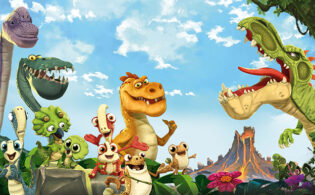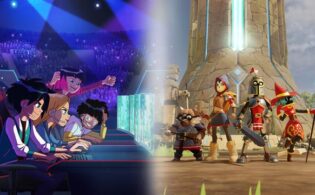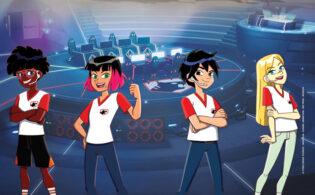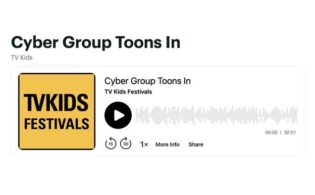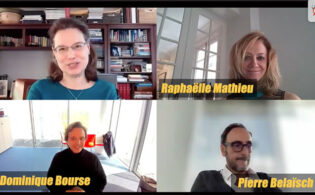Cyber Group Studios’ Pierre Sissmann, France Télévisions’ Christine Reinaudo and character designer Yann de Preval discussed the creative process behind 50/50 Heroes ahead of the premiere of a trailer for the brand-new series as the second day of the TV Kids Festival kicked off this morning.
Anna Carugati, group editorial director of World Screen and TV Kids, moderated the session, which opened with Sissmann, chairman and CEO of Cyber Group Studios, talking about the show’s origins. 50/50 Heroes, a 52×11-minute 2D-HD comedy for kids 6 to 10, follows Mo and Sam, half-siblings who discover they have inherited powers from their great-great-great-grandma who had a fling with a superhero many moons ago. As half-siblings, they must share these powers down the middle.
Sissmann said that a few years ago, he had become “fed up” with superhero series and was looking for a new take on the genre. “I said to my team, especially to Maud Chougui, who is an excellent development executive, You know what would be great? A series where superheroes are not superheroes.”
Chougui eventually returned to Sissmann with a half-page treatment that he immediately responded to, leading him to meet with the authors, Romain Gadiou and Chloé Sastre, and character designer Yann de Preval. The Cyber Group Studios team then took the project out to France Télévisions, pitching it to Pierre Siracusa, director of animation for the children and youth department, and Reinaudo, who is head of hybrid programs and new formats for youth at the pubcaster. “Each of the heroes learns something that shapes their personality and behavior,” Reinaudo said. “That is really important nowadays, especially since we are living with the pandemic. Chloé and Romain, the authors, combined with the great designs from Yann, [have created] a really original show.”
De Preval then talked about coming up with the look of the characters. “At first, I didn’t know a lot about them. I knew they were supposed to be stepbrother and stepsister. That was a good start. Sometimes it can be quite difficult to come up with a strong design because all you have are a few descriptions like, they are supposed to be 10 or 11 and that’s it. The concept was so strong with 50/50 Heroes that it was really easy to build on top of that. They are stepbrother and sister, so you know they can be different, but you need to find something to make them work together. For us, it was going with the strong blue color for the hair. You have something you can see immediately sets them apart from the rest. You know they are special, but it’s not too obvious either. From there, we tried to find a way to show their characteristics in the design. For example, Mo is a lazy kind of guy, always trying to find the easy way out. We wanted someone made like a noodle—the shape is a bit soft, not very strong, not very sharp. Whereas Sam is supposed to be really cute, so we tried to go with a rounder shape. She is supposed to love and cuddle pets. We knew those characteristics, and we tried to show them in the design.”
He added, “Like Pierre said, we’ve seen so many concepts about superheroes. Taking a different approach and going with the comedy aspect was really fun.”
Sissmann then elaborated on the story of Mo and Sam and how they have to work together to harness their inherited superpowers. “As siblings, brother and sister, they always agree, disagree, agree, disagree.” And if they don’t work together to activate a superpower, much can go wrong: “Let’s imagine there is a test in math and the boy says, I missed the test, I’m going to go back [in time] and take the test again. And the sister says, No, you won’t, and she sends him into the future—but she goes into the past. Unless they are together, [the superpowers don’t] work. Those incredible moments that are unreal make you laugh because you push a situation to an extreme. And that’s what we’ve been trying to do with the development team and with the help of Christine.”
Sissmann said he was immediately taken by de Preval’s character designs. “When I saw the first designs, I started laughing. I knew what the story was going to be, but I started laughing at the first illustrations. I think this is where Yann had a lot of talent to be able to translate into designs, into drawings, into illustrations, what Romain and Chloé invented.”
The panelists then discussed the collaboration involved in setting the animation style for the series. “We try to get the animation that fits the series,” Reinaudo said.
Sissmann added, “When you look at the design of Yann, you immediately think you can have stretch and squash. And that is typical 2D. Honestly, it was obvious that it would be 2D and very bright colors. It’s the universe that Yann has designed. It’s a happy universe; also, it’s a happy series. Christine is right. We do any style of animation at Cyber Group Studios. But it is the project that decides what style it will be.”
Reinaudo added, “The animation style fits perfectly with the storylines and with Yann’s designs.”
On the major themes of the upcoming series, Reinaudo said: “It’s not [about] asking for powers and then you are a superhero. Or that they are two step-siblings. For me, what is most important in this series is the emotional path. You need kindness; you need benevolence, especially nowadays. These storylines combine a real action series with, as Pierre and Yann said, comedy and joy. There is a lot of cohesion. Also, Mo and Sam need to put themselves in each other’s shoes. This is important to get mutual assistance and solidarity. [And the message that] you can’t always get what you want. You have to [work] together to succeed.”
The series is being produced at Cyber Group’s French studios. “France has some of the best animators in the world,” Sissmann said. “And we’re a French company. If we can work in our own country, it’s much better. We’re closer, we can go up and down and check things, correct things and develop talent.”
Carugati asked de Preval about his overall approach to character design, especially today when children are exposed to so much content, from TV to movies to video games and comic books. “I’m always trying to renew myself and update my designs. And at the same time, you can’t avoid having some gimmicks and a lot of stuff that is going to remind people of your style. Sometimes you try to find ways to get away from how you draw hands or expressions. Sometimes it’s easier to just go back to what you know. There is so much animation right now; you need to stand out among all the different shows. A few years back, producers used to say, ‘I need something that looks like this.’ Now, the references they have in mind are much wider and broader. It’s not just animation; it can be TV or comic books or even illustrators. [They want] something fresh and that has not been seen thousands of times before. It’s a really interesting time to be developing animation.”
The conversation then moved to managing production amid COVID-19 shutdowns. Cyber Group had already prepared for people to work remotely. “We are always trying to go where the talent is,” Sissmann said. “And maybe the talent is not where our studio is in Paris or Lille. Maybe it’s in the south of France. Maybe it’s in the center of France. So with our IT department, we had the ambition to try to have people work from remote wherever they are. When the pandemic hit, it did create an issue, but we were sort of prepared for it.”
Of the six shows in production at Cyber Group, three were impacted by the 2020 lockdowns, but because the company was able to set its talent up with everything they needed to work from home, “we caught up,” Sissmann said. “We are delivering all our series on time.”
In addition to France Télévisions, Disney Germany is a partner on the project. Sissmann said Dominique Neudecker, senior manager for acquisitions and co-productions at The Walt Disney Company Germany, found 50/50 Heroes to be a “great universe with strong and distinct characters and it’s very funny. She said it’s very relatable. She also said it’s a compliment to the authors and how we developed it with France Télévisions. [She said] it has emotionally touching stories for the core audience for Disney, which is gender-balanced, 6 to 10.”
Reinaudo added, “It’s purely original. It’s not an adaptation or something from another property. I think that’s also the [sign of] a great team because everybody has to push himself to be able to bring innovative ideas and some tricky effects that you don’t have on different projects.”
Carugati asked Reinaudo how France Télévisions has been serving young viewers since the onset of the pandemic. “We need to gather children in front of good productions more than ever. We need comedies that bring something new, something deeper in their message. That’s why [50/50 Heroes] is good for us. It’s important to gather children to face their own difficulties in their daily life. With this series they have to decide what to do. I think it’s the most important message that we can bring in this very unusual and difficult period.”
The conversation was followed by a sneak peek at 50/50 Heroes.
 TVKIDS
TVKIDS
